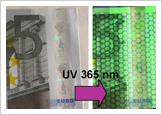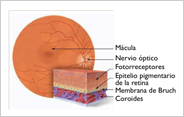Knowledge Transfer
Biomimetic Polyester
CSIC and the University of Málaga have patented a new procedure for the synthesis of polyaleurate polyester, a mimetic polymer of plant cutin, and its use as a biodegradable packaging material for food or active ingredients. It consists of a non-toxic plastic polymer which can be obtained from raw materials coming from vegetable wastes. |
Nanostructured material for the absorption of organic pollutants in water CSIC has patented a new material based on high-charged synthetic mica unique for its organophilic properties. The material is very interesting for wastewater treatment by is capacity to remove organic pollutants over a wide range of industrial wastes in water. It can be optimized for each specific waste present in water to comply with the strictest environmental laws. Partners interested in a patent license are being sought. |
New encrypted tag system for tagging and tracking objects CSIC in collaboration with Polytechnic University of Madrid has developed a new method to tag objects that consists in fabricate on them one or more nanometer-thick and invisible layers by plasma polymerization. Any kind of pattern can be recorded in these layers, by laser or other techniques, allowing its recognition, control and tracking. Highly complex patterns containing much information can be recorded. An offer for Patent Licensing. |
CO2 and SO2 sequestration using industrial waste at room temperature A Spanish public research organisation and two universities from Spain have developed a process that allows mineral sequestration of CO2 and SO2, gases that trigger the greenhouse effect and acid rain respectively. The process is based on the reuse of calcium-rich industrial waste produced by many types of industries, performed at room temperature and outdoors, so it’s an easier and cheaper process than the existing ones. An offer for Patent Licensing. |
Metal nanoparticles functionalized with fluorescent organic molecules CSIC organization and University Pablo de Olavide have developed new metal nanoparticles functionalized with fluorescent organic molecules, whose fluorescence is not turned off by the proximity of the metal, stable in aqueous medium, which may be functionalized with molecules of interest (eg antibodies for biomedical applications) and biocompatible. These nanoparticles can be detected by other techniques other than fluorescence like UV-Vis, IR and Raman. An offer for Patent Licensing. |
Versatile and economical method of manufacturing mixed oxides thin films
CSIC organization has developed a process for the manufacture of thin films of mixed oxides. The method allows the controlled deposition of oxides of a variety of metals in a simple and economical way. It consists in evaporating metalorganic compounds of the desired metal that are subsequently decomposed by the plasma action, resulting in the An offer for Patent Licensing |
Kalsilite production optimized new process
CSIC organization has patented a new method to synthesize higher purity kalsilita (KAlSiO4) from an easily available precursor, kaolinite, under mild conditions of pressure and temperature and with a substantially time and costs reduction of the process. The kalsilita is used as the precursor of leucite, a major component in the porcelain-fused-to-metal and An offer for Patent Licensing |
Optically tailored nanovoid coatings CSIC has patented a new coating with the particularity that contains closed nanopores (nanovoids of 1-50 nm diameter). The manufacture control of the coating microstructure determines the refractive index, color, density, mechanical and other coating properties. This possibility makes the invention useful for a wide range of applications from filters and reflectors working in the desired in wavelength, beyond tunable color coatings, heat accumulators for construction and efficiency enhancer of solar cells, without modifying the chemical, thermal and mechanical stability. The new manufacturing method is based on a fully operational technology, so can be easily implemented in the current processing lines to manufacture coatings in industrial scale. An offer for Patent Licensing |
Tunable and flexible mirror/filter for coating CSIC has developed a new coating that functions as a color selective mirror/filter, serving to shield certain radiation in the ultraviolet range, visible or near infrared. It is a flexible material that adapts to different types of substrates and form, providing the choice of color and protection. The innovative solution found is based on the nanostructured coating formed by nanometer thick layers of different oxides. In that sense, the mechanism of light selection does not involve light absorption and thus avoid unwanted overheating of the coating. An offer for Patent Licensing. |
Gold catalyst support of H2 generation that reaches a 100% CO conversion
Spanish public research organisations have developed a new gold catalyst for the Water Gas Shift Reaction (WGSR) useful for the production and/or purification of H2 for applications in fuel cells. It is a catalyst capable of working at low temperatures in the range in which the reaction is thermodynamically more efficient. It has a high stability An offer for Patent Licensing |
Smart management of industrial waste for CO2 sequestration CSIC organization, University of Seville and University of Cádiz have developed a method to recycle the industrial waste as alternative to the current standards for CO2 sequestration, under ambient temperature and pressure conditions. The new process is suitable for the treatment of calcium-rich waste, presenting this double and simultaneous benefit, the CO2 capture and recycling of waste. Is an innovation in the field of greenhouse gases reduction, whose main advantages are the costs reduction, low complexity and low energy consumption. An offer for Patent Licensing |
Método para fabricar materiales avanzados por concentración de corriente eléctrica La US y el CSIC patentan un método para fabricar materiales avanzados por concentración de corriente eléctrica. Los investigadores han diseñado un molde que permite ahorrar hasta 100 veces la energía necesaria para la creación de este tipo de materiales, útiles principalmente en la industria aeroespacial, automovilística y biosanitaria. Se buscan socios industriales para la licencia de la patente. |
Membrana reabsorbible para regeneración ósea guiadaEl CSIC, en colaboración con el Sistema Sanitario Público Andaluz y las Universidades de Sevilla y Cádiz, ha desarrollado un método de obtención de membranas poliméricas biodegradables y reabsorbibles para su uso en regeneración ósea guiada. El método, basado en el tratamiento por plasma de una de las caras de la membrana y mediante el depósito, por técnicas de vía seca, de capas nanométricas de óxidos activos en la otra cara, permite controlar la degradación del material implantado y favorecer la formación de tejido óseo en el proceso de cicatrización sin tener que retirar la membrana. Se buscan socios industriales para la licencia de la patente. |
Material heteroestructurado con propiedades fotocatalíticas bajo irradiación solarEl CSIC ha desarrollado un método de obtención de un material heteroestructurado que, basado en BiVO4 y dopado con Er3+, presenta excelentes prestaciones como fotocatalizador bajo irradiación solar. El método de preparación, a través de una ruta sintética específica y que utiliza un tratamiento hidrotermal asistido por microondas, induce la estabilización del BiVO4 en una fase tetragonal predominante, incluso con reducidos contenidos de Er3+, y hace al material resultante útil en la degradación de contaminantes orgánicos en fase acuosa o gaseosa. |
Composition of biopolymers for the cultivation of pluripotent cells and retinal pigment epithelium cells CSIC and Fundación Progreso y Salud have developed a biopolymer-based composition that mimics the natural extracellular matrix of the retinal pigment epithelium. The present invention is useful for the culture of induced pluripotent cells and retinal pigment epithelium cells. Industrial partners from health, pharmaceutical or ophthalmological companies are being sought to collaborate through a patent licence agreement. |
icms











